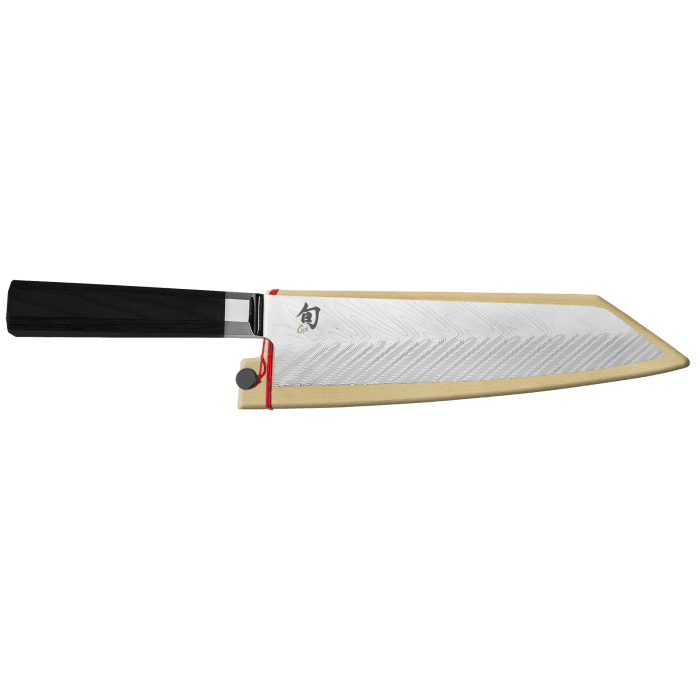Shun Dual Core Kiritsuke 8"
Shun Dual Core Kiritsuke 8"
SKU: VG0017
In Japan, the kiritsuke is known as the master chef's knife. Use it for all the tasks for which you'd use a chef's knife. It works extremely well with vegetables; julienne, dice, or brunoise with ease. It's also an excellent choice for cleaning and portioning boneless proteins, and particularly fish. It slices cooked proteins with grace and ease. With its straighter edge, it's ideal for slicing cuts and push cuts. The Shun Dual Core Kiritsuke was chosen as the 2014 Kitchen Knife of the Year by Blade Magazine.
- A work of culinary art and top performance; includes wooden saya (shealth)
- 71 alternating micro-layers of high-carbon, high-chromium VG10 & VG2 stainless steel extend all the way to the edge to maintain long-lasting high-performance; razor-sharp 16° edge
- Traditional octagon-shaped handle in ebony PakkaWood® provide a comfortable, secure grip; beautiful, durable PakkaWood won't harbor bacteria
- Rabbet tang controls weight and enhances maneuverability; this tang type is how samurai swords were commonly constructed
- Handcrafted in Japan
Dimensions & Capacities
Dimensions & Capacities
Materials
Materials
Blade Steel: 71-layer Damascus VG10 & VG2 Handle Material: Ebony color Pakkawood
Glaze Imperfections
Glaze Imperfections
Use & Care Instructions
Use & Care Instructions
Caring for Your Cutlery
One aspect of caring for your knives is maintaining the edge and, when needed, sharpening the blade. But it’s also important to be aware of how you’re using your knives on a daily basis.
Cutting technique
Shun cutlery is designed to be used in a smooth, slicing motion—never in an up-and-down “chopping” manner. Imagine cutting wood with a handsaw, then slice through your food with a similar motion, intentionally pushing the knife forward and down as you slice, then pulling it back toward your body. Always pay attention to where your fingers are in relation to the knife. Your skill and experience level should determine the speed at which you cut. When first slicing with a Shun, it’s best to slow down and enjoy the effortless precision and cutting ability of your new knife. The only exception is when using Shun cleaver blades, which can be chopped with.
Please do not use Shun knives on bones, joints, or frozen foods. Shun knives are designed for precision slicing rather than crushing down through hard materials.
When your kitchen tasks call for cutting through hard foods, such as winter squash or produce with thicker, tougher rinds, like pineapple or watermelon, we recommend using the Shun Classic Western Cook’s Knife. This knife has been sharpened to a slightly wider angle, 22° on each side, to take on these heavier, harder foods. When cutting hard foods like these, you may find that the knife sticks in the food on occasion. If this happens, don’t twist the knife to the side to free it; that could damage the blade. Instead, lift the knife straight up and continue cutting. A handy tip for cutting hard vegetables, such as squash, is to heat the vegetable in the microwave briefly to soften it slightly before cutting.
Cutting surface
The cutting surface you use makes a big difference in keeping your knives sharp. A good cutting board will help retain a sharp edge substantially longer. Medium-soft woods, such as hinoki, are preferred. Tile, ceramic, synthetic, marble, granite, or any kind of glass cutting boards are not recommended and can be very hard on your knives.
Washing & drying
It is important to protect your investment by hand washing your knives with gentle dish soap. Do not use soaps with citrus extracts or bleach; they can promote rust. Hold the knife flat against the back wall of the sink. Gently wash the exposed side with warm, soapy water. Turn the knife over and repeat. Rinse and towel dry immediately. Do not leave your knife sitting in a sink full of soapy water. It is hard on metals to be submerged in water for prolonged periods, and it’s a danger when you reach in.
Handwashing is also the best way to care for the wood handles of your Shun knives. Although the wood has been stabilized, it is natural wood and, like all wood, will tend to shrink in very arid environments and swell in very humid environments. The handle color may change slightly over time due to oils in the hand as well as the natural color change of wood from oxidation and/or exposure to light. This is not a defect, but a natural part of the process.
After handwashing your Shun knives, dry them immediately using a soft and absorbent dishtowel. Leaving water or any dampness on your knives can cause rusting. A thorough drying will help maintain your knives properly. Allowing them to air dry for a little while before storing helps, too.
Storage
It is best to store your Shun cutlery in a wooden block, in-drawer knife tray, sheath, or knife case. Do not store your knives unsheathed in a drawer.
Warranty
Warranty
Limited Lifetime Warranty.
For more information, see https://shun.kaiusa.com/warranty/
California Prop 65 / AB1200 Warning
California Prop 65 / AB1200 Warning
Shipping & Handling
Shipping & Handling
Share


